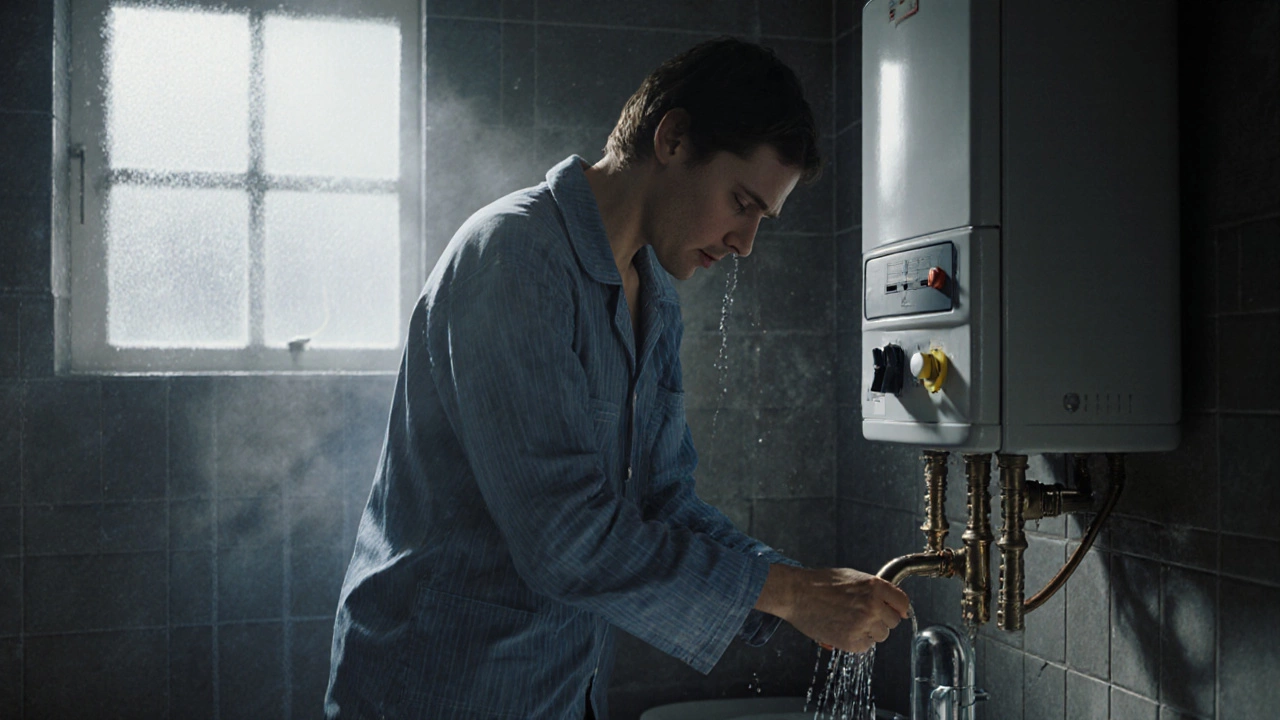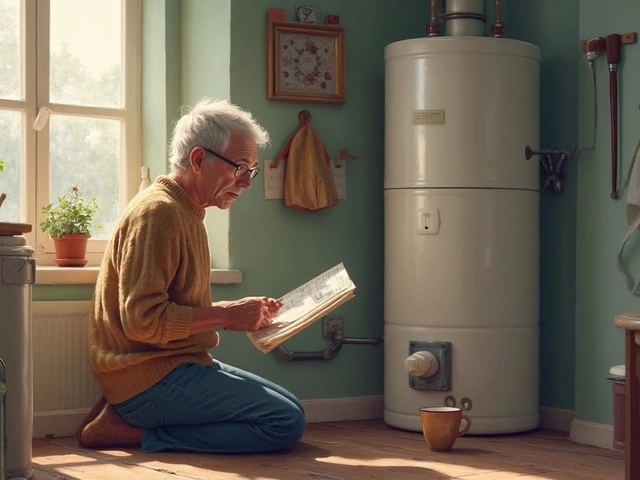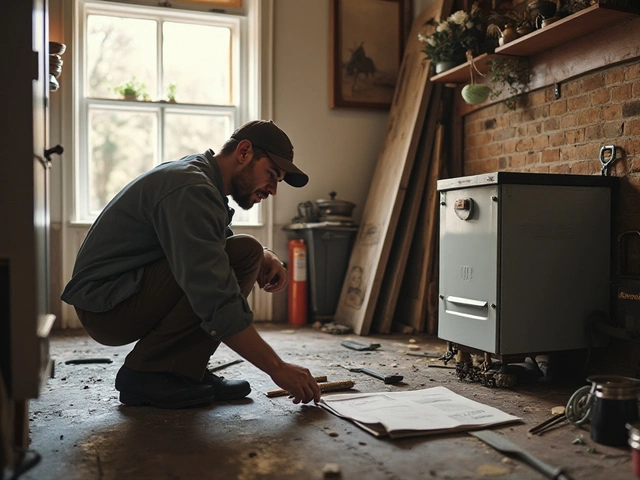You turn on the shower, wait for the water to warm up-and nothing. Just cold. You try the kitchen sink. Same thing. You check the bathroom tap. Still no hot water. It’s 7 a.m. on a Tuesday, and you’re standing there in your pajamas, wondering what just broke. If you’ve ever faced this sudden cold water shock, you’re not alone. In Adelaide, where winters can dip below 5°C, losing hot water isn’t just inconvenient-it’s uncomfortable, even unsafe. The good news? Most of the time, it’s not a full system failure. It’s something simple you can fix yourself-or know when to call a pro.
Is it just your hot water, or is it the whole house?
First, check if the problem is isolated to one tap or affects every outlet in the house. If only the bathroom sink has no hot water, the issue is likely a local valve or pipe blockage. But if every tap, shower, and washing machine inlet is giving you ice-cold water, then your water heater is the culprit. This is the most common scenario.
Most Australian homes use either an electric storage tank heater or a continuous flow (instantaneous) gas heater. The fix depends on which one you have. If you’re not sure, look at the unit. Electric heaters usually have a large metal tank (50-300L) with a power cable plugged into the wall. Gas heaters are slimmer, often mounted on a wall, and have a gas pipe connected to them. You’ll also see a small exhaust vent near the top.
Electric water heater? Check the power first
If you’ve got an electric system, the most likely cause of no hot water is a tripped circuit breaker or a faulty thermostat. Start at your switchboard. Look for a breaker labeled "Water Heater," "EHW," or "Hot Water." If it’s flipped to the OFF position, reset it. If it trips again right away, don’t keep resetting it-that’s a sign of a serious electrical fault. Call an electrician.
If the breaker is fine, the problem might be the thermostat. Older electric heaters have two thermostats: one upper and one lower. If the upper one fails, you might get a little hot water at first, then nothing. If the lower one fails, you’ll get cold water from the start. Neither is easy to fix without tools, but you can test it. Turn off the power at the switchboard. Remove the access panel on the side of the tank. Look for a small red button-this is the reset switch. Press it firmly. You might hear a click. Turn the power back on and wait 30 minutes. If hot water returns, the thermostat was just overheating. If not, it’s likely broken.
Most electric water heaters in Adelaide last 8-12 years. If yours is older than that and the reset button doesn’t help, it’s probably time to replace it. Newer models are more energy-efficient and come with better warranties.
Gas water heater? Check the pilot light
If you’ve got a gas heater, the most common cause of no hot water is a blown-out pilot light. This is especially true in winter when drafts are stronger or the gas supply is low. Most gas heaters have a small window or access panel on the front where you can see the flame. If it’s out, you’ll need to relight it.
Here’s how:
- Turn the gas control knob to "OFF" and wait 5 minutes to let any gas clear.
- Turn the knob to "PILOT."
- Press and hold the pilot button (or the knob itself, depending on model).
- While holding it down, use a long lighter or match to ignite the pilot through the access hole.
- Keep holding the button for 30-60 seconds after the flame lights. This lets the thermocouple heat up.
- Release the button. If the flame stays lit, turn the knob to "ON."
If the pilot won’t stay lit after three tries, the thermocouple is probably faulty. It’s a small copper tube that senses heat and tells the gas valve to stay open. If it’s dirty or broken, the gas shuts off. You can clean it with fine sandpaper or replace it-it’s a $40 part and takes 20 minutes. If you’re not comfortable doing it, call a licensed gas fitter. Never ignore gas smells. If you smell gas at any point, turn off the main valve, open windows, and call your gas provider immediately.

Is your water heater leaking?
A sudden loss of hot water can also mean your tank is leaking. Check the base of the heater for puddles. A small drip might mean a loose fitting. A steady stream or rust stains? That’s tank corrosion. Once the tank starts leaking, it’s not repairable. You’ll need a replacement.
Some people try to patch leaks with epoxy or sealant. Don’t. Water under pressure will break through. And if it’s an electric heater, water near the wiring is a serious electrocution risk. If you see water pooling, shut off the power (for electric) or gas (for gas) and the water supply valve on top of the tank. Then call a plumber. Waiting makes it worse-and more expensive.
Thermostat set too low?
It sounds obvious, but people forget. Maybe someone adjusted the temperature down to save energy-or your kids turned it off after a shower. Check the dial on your heater. Most units are preset to 60°C, which is the recommended safety level to kill bacteria like Legionella. If it’s set to 40°C or lower, you’ll get lukewarm water at best. Turn it up to 60°C and wait an hour. If hot water returns, that was your problem.
Don’t set it higher than 60°C. Above that, you risk scalding, especially for kids and elderly people. Install anti-scald valves if you’re worried.
Is your system undersized?
If your water heater is old and you’ve added more people to the household, you might just be running out of hot water faster than it can recover. A 135L tank might’ve been fine for two people, but now with three teenagers and a washing machine that uses hot water every day? You’re draining it faster than the heater can refill.
Signs you’re undersized:
- Hot water lasts 10 minutes or less in the shower
- It takes over an hour to recover after a full drain
- You’ve noticed this getting worse over the last year
If this sounds familiar, consider upgrading to a larger tank (160L-250L) or switching to a continuous flow gas heater. These units heat water on demand, so you never run out. They’re more expensive upfront but cheaper to run long-term.

What about solar or heat pump systems?
Many Adelaide homes use solar or heat pump water heaters. These are great for saving money-but they’re more complex. If you’ve got one and no hot water, check the controller screen. Does it say "Fault" or show an error code? Common issues include pump failure, sensor malfunction, or low refrigerant levels. These systems require a qualified technician to diagnose. Don’t try to open the panels or touch the pipes yourself. The refrigerant lines are under pressure and can be dangerous.
Also, solar systems rely on sunlight. On a cloudy winter day, your booster (usually electric or gas) should kick in. If it doesn’t, the booster element or thermostat has failed. Again, this needs professional attention.
When to call a professional
You can fix a tripped breaker, relight a pilot, or adjust a thermostat yourself. But if you’ve tried those steps and still have no hot water, it’s time to call someone. Here’s when:
- You smell gas at any time
- The breaker trips repeatedly
- You see water leaking from the tank
- The heater is over 10 years old and keeps breaking
- You’re not comfortable working with electricity or gas
Don’t risk your safety. A licensed plumber or electrician can diagnose the issue in under an hour. In Adelaide, most call-out fees are $100-$150, but they’ll give you a quote before doing any work. Many will even waive the call-out fee if you go ahead with the repair.
Prevent it from happening again
Once your water heater’s fixed, do a few simple things to keep it running:
- Flush the tank once a year to remove sediment (especially if you have hard water)
- Check the pressure relief valve every six months-lift the lever to make sure water comes out
- Set the temperature to 60°C
- Install a timer on electric heaters to run only during off-peak hours
- Replace the anode rod every 3-5 years (this stops the tank from rusting from the inside)
These small habits can double the life of your heater and save you hundreds in repairs.
Why is my hot water suddenly cold?
The most common reasons are a tripped circuit breaker (for electric heaters), a blown pilot light (for gas heaters), a faulty thermostat, or a leaking tank. It’s rarely a complete system failure-most times, it’s a simple fix you can do yourself.
Can I fix my water heater myself?
Yes, if you’re comfortable with basic tools and safety. You can reset a breaker, relight a pilot, or adjust the thermostat. But don’t touch electrical wiring, gas lines, or pressurized systems unless you’re trained. When in doubt, call a pro.
How long should hot water last in a shower?
A standard 135L electric tank should give you 15-20 minutes of hot shower time. If you’re getting less than 10 minutes, your tank might be too small, the thermostat is set too low, or sediment has built up inside.
Should I repair or replace my water heater?
If your heater is under 8 years old and the issue is a simple part (like a thermostat or anode rod), repair it. If it’s older than 10 years, leaking, or needs expensive parts, replacement is more cost-effective. New models are 30% more efficient and come with 10-year warranties.
Do I need a plumber or an electrician?
For gas heaters and pipe leaks, call a licensed plumber. For electric heaters with wiring or thermostat issues, call a licensed electrician. Some plumbers are qualified to work on both-ask before booking.







